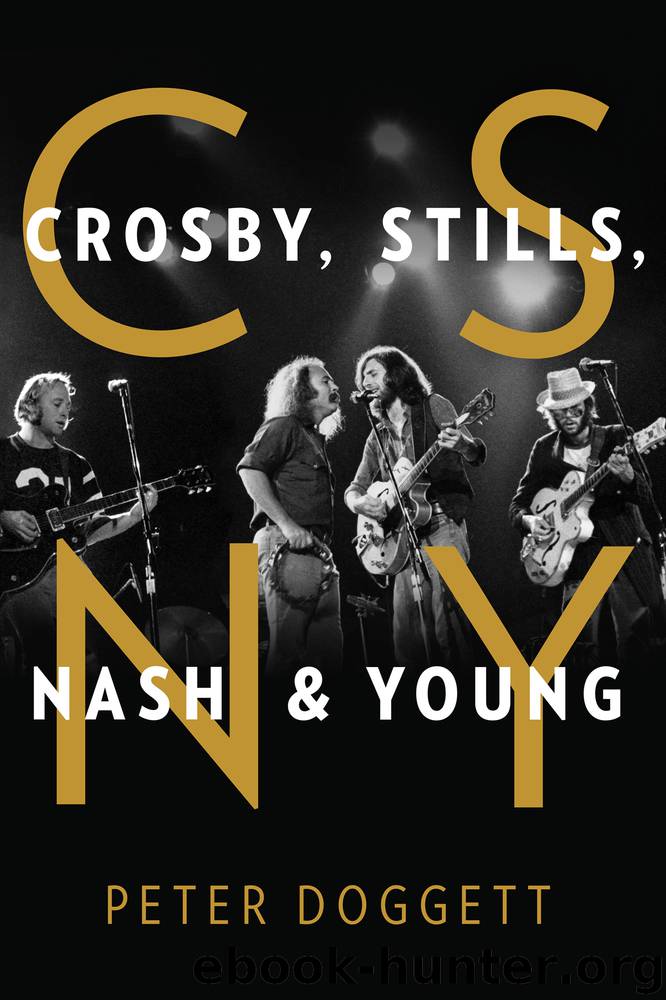CSNY: Crosby, Stills, Nash and Young by Peter Doggett

Author:Peter Doggett [Doggett, Peter]
Language: eng
Format: epub
ISBN: 9781501183027
Google: N9aLDwAAQBAJ
Amazon: 1501183028
Goodreads: 42101684
Publisher: Atria Books
Published: 2019-04-01T16:00:00+00:00
Getting that second album was like pulling teeth . . . There was song after song that didn’t make it.
—Stephen Stills, May 1970
Crosby, Stills & Nash documented a musical love affair, a unique harmony blend, and a moment in Laurel Canyon history. From the start, its follow-up was less focused, more uncertain, and clouded with sorrow.
Despite the group’s claim to be a collection of individuals, CSN’s commercial success had spawned an industry, with all the legal ties that entailed. They had joint management and a joint recording contract, although that only stipulated the presence of CSN, not Y. (The Atlantic deal was amended to ensure that records by CSNY counted toward CSN’s contractual obligations, with proceeds split equally between the four musicians. But Young retained his independence as a solo artist, remaining on Atlantic’s half-sister label, Reprise Records.) Now they had to deliver an album that would capture both the individual talents of CSNY and the mesmeric power that they had already demonstrated onstage. Key to that power was their rhythm section, and for this album, CSNY wanted Dallas Taylor and Greg Reeves identified as fully fledged members rather than sidemen. Their generosity only went so far: the drummer and bassist wouldn’t be given an equal share of the profits. But as Neil Young declared during the recording sessions, “They really hold the whole thing together.” Young admitted that he and Taylor had taken time to bond, but now Young realized that “he is just like me.”
Consciously or otherwise, the San Francisco sessions were divided along the same lines as CSNY’s live shows. Some songs required the full band; others only two or three members. Given the checkered history of Buffalo Springfield, the obvious threat to the project was a clash of egos between Stephen Stills and Neil Young. Graham Nash identified each of them as “a genius,” a description he didn’t apply to himself or Crosby—thereby creating a creative hierarchy within this partnership of supposed equals. But, as Crosby would write about the band several years later, “Who gets to be the boss of this bunch?”
Commercially, there was only one answer: the man who had dominated a million-selling album easily outweighed the newcomer whose two solo records had barely registered on the public consciousness. Certainly, Stephen Stills approached the sessions as if, once again, everything depended on him. If his schedule on the CSN album had been punishing, it now approached manic proportions—thanks in part to the way it was fueled. “There was so much cocaine around,” Dallas Taylor recalled, “and Stephen and I would just eat up anything that was there. It was crazy—I was crazy, and Stephen was definitely crazy.” Together, the two musicians put in eighteen-hour working days, with engineers struggling to stay alive in their wake. “I’d get up at five in the afternoon,” Stills explained, “have breakfast, go to the studios, and stay there till noon the next day and then go home and collapse. That went on for three weeks.” Even then, Stills would not be satisfied.
Download
This site does not store any files on its server. We only index and link to content provided by other sites. Please contact the content providers to delete copyright contents if any and email us, we'll remove relevant links or contents immediately.
| Actors & Entertainers | Artists, Architects & Photographers |
| Authors | Composers & Musicians |
| Dancers | Movie Directors |
| Television Performers | Theatre |
Cecilia; Or, Memoirs of an Heiress — Volume 3 by Fanny Burney(31822)
Cecilia; Or, Memoirs of an Heiress — Volume 2 by Fanny Burney(31801)
Fanny Burney by Claire Harman(26508)
We're Going to Need More Wine by Gabrielle Union(18951)
Plagued by Fire by Paul Hendrickson(17314)
All the Missing Girls by Megan Miranda(15489)
Cat's cradle by Kurt Vonnegut(15152)
Bombshells: Glamour Girls of a Lifetime by Sullivan Steve(13952)
Leonardo da Vinci by Walter Isaacson(13147)
For the Love of Europe by Rick Steves(12640)
4 3 2 1: A Novel by Paul Auster(12263)
Adultolescence by Gabbie Hanna(8836)
The remains of the day by Kazuo Ishiguro(8788)
Note to Self by Connor Franta(7606)
Diary of a Player by Brad Paisley(7460)
Giovanni's Room by James Baldwin(7162)
What Does This Button Do? by Bruce Dickinson(6123)
Born a Crime by Trevor Noah(5273)
Ego Is the Enemy by Ryan Holiday(5266)
